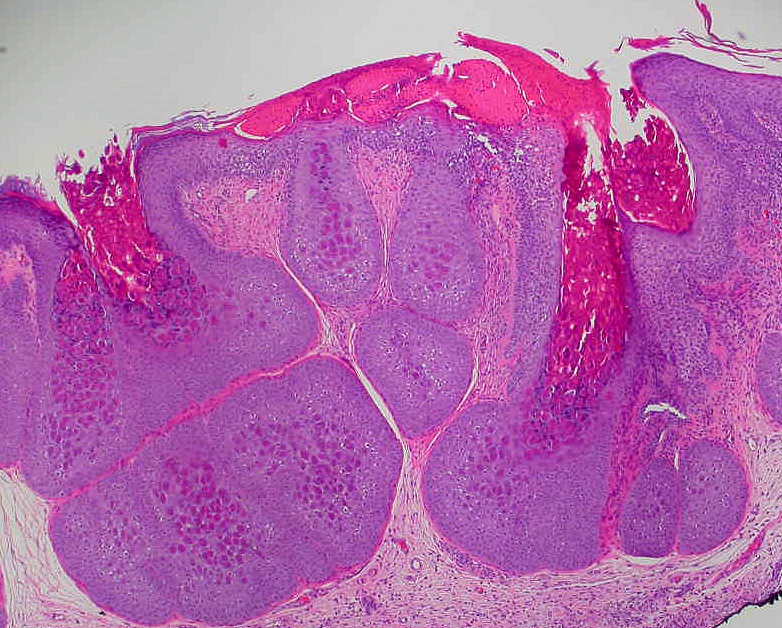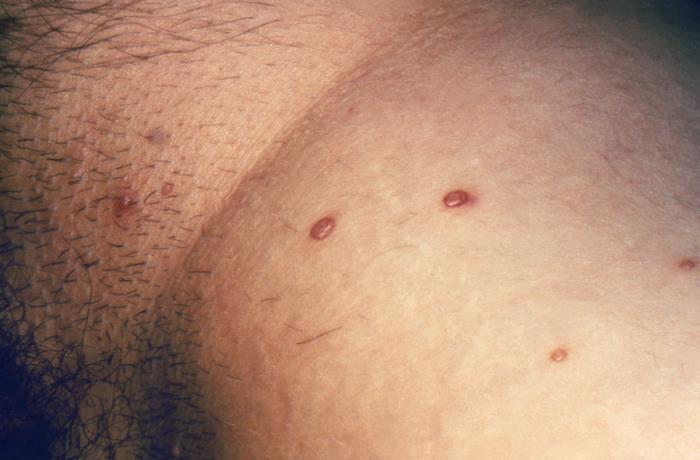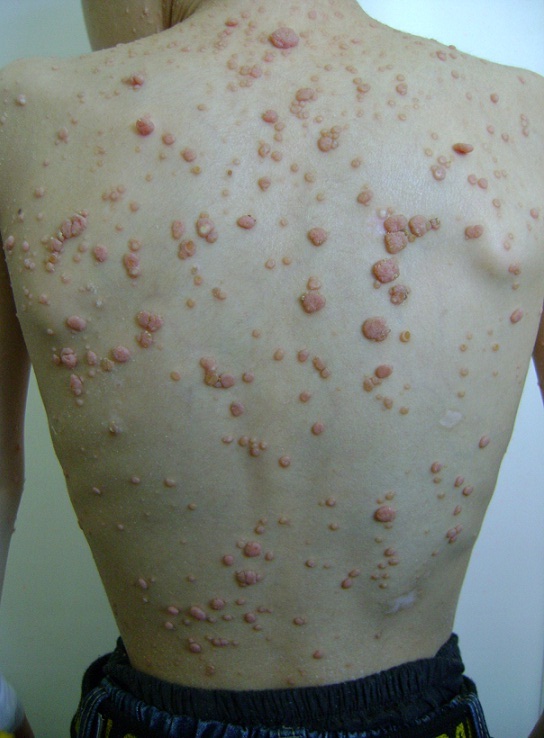Molluscum contagiosum is a viral infection limited to the epidermis, typically without systemic manifestations. This infection is common in children below 5 years of age, though it can also be seen in healthy adolescents and adults, typically related to either contact sports or, with lesions on the genitals, as a sexually transmitted infection (STI). Lesions appear as grouped, flesh-colored, dome-shaped papules with central umbilication. Molluscum contagiosum is mild in immunocompetent patients and self resolves within months. Immunocompromised individuals present with extensive lesions which require treatment. Molluscum contagiosum is highly transmissible; therefore, patient education is key in its management. Cryotherapy with liquid nitrogen is the 1st-line treatment.
Last updated: Sep 10, 2025

Henderson-Paterson bodies:
Characteristic histological features of molluscum contagiosum. Henderson-Paterson bodies are inclusions that are visible in the keratinocytes of the basal, spinous, and granular layers of the epidermis.

Dermatologic manifestation of molluscum contagiosum:
Flesh-colored pearly papules with central umbilication are present in the inguinal region, suggestive of molluscum contagiosum.

Multiple instances of molluscum contagiosum on the back of a child:
Flesh-colored pearly papules with central umbilication
There is no consensus on optimal treatment.
Typical 1st-line therapies recommended by experts include:[1-5]
Other potential treatment options include:[3,5]
Immunocompromised immunocompromised A human or animal whose immunologic mechanism is deficient because of an immunodeficiency disorder or other disease or as the result of the administration of immunosuppressive drugs or radiation. Gastroenteritis patients Patients Individuals participating in the health care system for the purpose of receiving therapeutic, diagnostic, or preventive procedures. Clinician–Patient Relationship:[1,5,9]
In pregnancy Pregnancy The status during which female mammals carry their developing young (embryos or fetuses) in utero before birth, beginning from fertilization to birth. Pregnancy: Diagnosis, Physiology, and Care:[3,5]
Diagnosis Codes:
This code is used to diagnose
molluscum contagiosum
Molluscum contagiosum
Molluscum contagiosum is a viral infection limited to the epidermis and is common in children below 5 years of age. Lesions appear as grouped, flesh-colored, dome-shaped papules with central umbilication.
Molluscum Contagiosum, a common viral
skin
Skin
The skin, also referred to as the integumentary system, is the largest organ of the body. The skin is primarily composed of the epidermis (outer layer) and dermis (deep layer). The epidermis is primarily composed of keratinocytes that undergo rapid turnover, while the dermis contains dense layers of connective tissue.
Skin: Structure and Functions infection that causes round, firm, painless bumps with a characteristic central dimple.
| Coding System | Code | Description |
|---|---|---|
| ICD-10-CM | B08.1 | Molluscum contagiosum Molluscum contagiosum Molluscum contagiosum is a viral infection limited to the epidermis and is common in children below 5 years of age. Lesions appear as grouped, flesh-colored, dome-shaped papules with central umbilication. Molluscum Contagiosum |
| SNOMED CT | 186362002 | Molluscum contagiosum Molluscum contagiosum Molluscum contagiosum is a viral infection limited to the epidermis and is common in children below 5 years of age. Lesions appear as grouped, flesh-colored, dome-shaped papules with central umbilication. Molluscum Contagiosum (disorder) |
Procedures/Interventions:
These codes represent common destructive therapies used to treat molluscum lesions for cosmetic reasons or to prevent spread, including
cryotherapy
Cryotherapy
A form of therapy consisting in the local or general use of cold. The selective destruction of tissue by extreme cold or freezing is cryosurgery.
Chondrosarcoma (freezing) and
curettage
Curettage
A scraping, usually of the interior of a cavity or tract, for removal of new growth or other abnormal tissue, or to obtain material for tissue diagnosis. It is performed with a curet (curette), a spoon-shaped instrument designed for that purpose.
Benign Bone Tumors (scraping).
| Coding System | Code | Description |
|---|---|---|
| CPT | 17110 | Destruction of benign Benign Fibroadenoma lesions other than skin Skin The skin, also referred to as the integumentary system, is the largest organ of the body. The skin is primarily composed of the epidermis (outer layer) and dermis (deep layer). The epidermis is primarily composed of keratinocytes that undergo rapid turnover, while the dermis contains dense layers of connective tissue. Skin: Structure and Functions tags or cutaneous vascular proliferative lesions Proliferative Lesions Fibrocystic Change; up to 14 lesions |
References